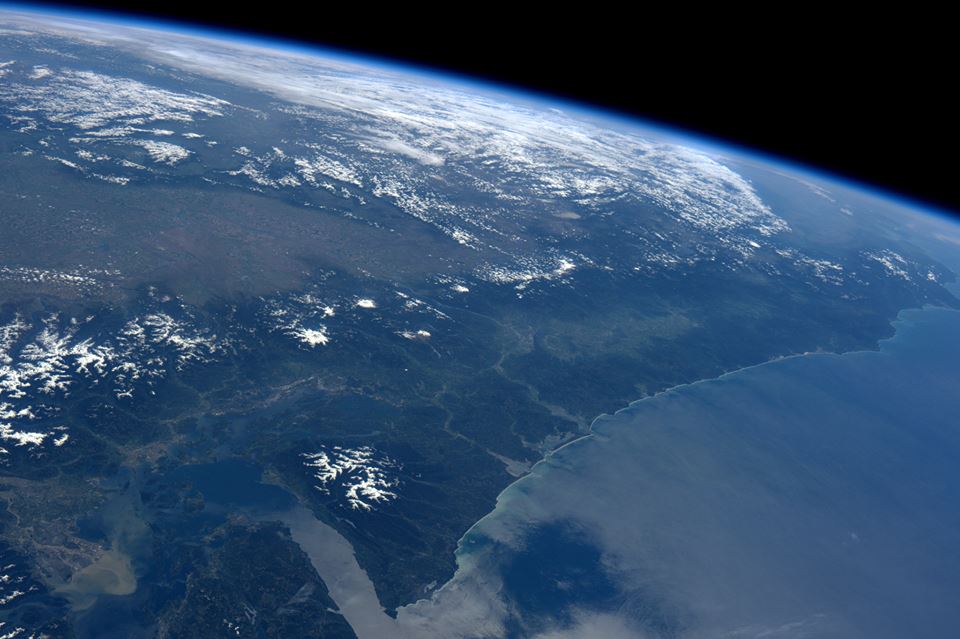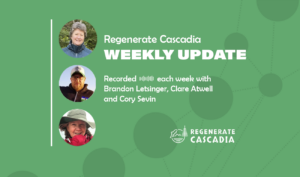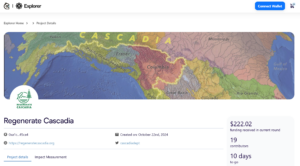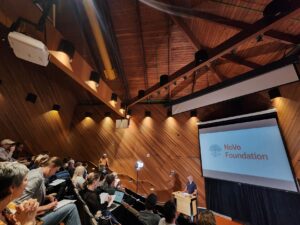Brandon and Clare gave a quick update on Regenerate Cascadia before recapping the most recent webinar given by Joe Brewer and the Design School for Regenerating Earth as part of the Birthing Bioregional Learning Center Learning Journey. In addition, the group discussed the importance of regenerative finance, the need for a coherent narrative, and the fragmentation of shared stories in the digital age. Finally, they broke into two groups, one for the Salish Sea and one for the Willamette Valley and Columbia River. Lastly, they planned for community engagement and mapping processes at different scales, emphasizing the need for ongoing peer support.
Regenerative Finance and Bioregional Learning
Ben appreciated the group’s interconnectedness and sense of purpose, while Clare discussed Joe’s complex presentation and real-world application. Brandon reported on the halfway progress of the learning journey, focusing on governance and a regenerative finance lab to support their work. Brandon introduced the concept of regenerative finance and the idea of a bioregional learning ecosystem, emphasizing the importance of breaking project silos and pooling resources. Clare discussed the relationship between value creation and life flourishing and highlighted the challenges of transitioning from an extractive to a regenerative economic system. The importance of understanding the story of a place and simultaneously inhabiting both the current and future worlds was emphasized.
Creating Coherent Narratives for Social Change
Paulé, Brandon, Ben, Clare Attwell, and Jan discussed the fragmentation of shared stories age and the need for coherent narratives that promote social dreaming and imagination. They agreed on the importance of developing a collective narrative to unify their message and the need for a positive narrative that motivates people and brings about desired change. Clare Attwell, emphasized the importance of having a clear vision to guide their work, while Jan suggested focusing on values that contribute to a quality of life instead of just economic value. The group also discussed the concept of multicapital, noting that it encompasses more than just financial capital, and highlighted the distortions in valuing and tracking only the financial aspects of things. They emphasized the importance of alternative storytelling in breaking free from a distorted perspective.
Bioregional Mapping Process and Learning Centers
Clare Attwell, proposed dividing the group into smaller ones to discuss their respective landscapes and encouraged the application of learned theory. Brandon was tasked with developing a question to facilitate experimentation and the generation of new ideas. The group also discussed the organization of a bioregional mapping process in the community, with Clare emphasizing the potential of this tool in understanding the system as a whole and the importance of clarifying the purpose and larger vision. Three groups were formed for the bioregional mapping process: a Salish Sea group, an Upper Columbia group, and a Willamette Valley group. The goal of the mapping process is to start regional learning centers and landscape hubs, with Jonathan and Victoria expressing their interest in joining the Willamette Valley group.
Community Engagement and Mapping Strategies
The group discusses how to approach community engagement and mapping processes at different scales, from smaller local communities to the broader Salish Sea bioregion. They explore starting with existing core groups versus bringing together a larger network, incorporating storytelling and artistic elements, and balancing concrete resource mapping with capturing the felt sense of place over deep time. Key points are identifying energized individuals ready to move forward, utilizing processes like community art projects to make active networks visible, and considering the developmental learning journey required for this work. The need for ongoing peer support among those engaged in these efforts is highlighted.
Notes from the Willamette Valley and Columbia River Group:
- People wanted to know The Plan. “Hippies did this in the 60s.” Gatherings with people outside of EC need lots of mediation and listening to fine-tune and coalesce, and there need to be lots of strong voices.
- Tons of resources and ideas, people didn’t step up to lead, it’s a long process, and we’ll do this every month “If we’re just going to talk every time without doing something, I don’t want to do that,”
- Wanted to create a “watering hole” physical gather + digital tools for online gathering. Ultimately a good strategy, where do we goi from here?
- When doing an initial gathering….How to find the balance between offering some orienting framing that is understandable and attractive, and also make it participatory. Need to understand the developmental learning aspects of community education and learning.
- Important to remember the phases of our own developmental learning to bring us into this engagement….it takes time, exposure, articulation, stories, etc
- “greater Columbia/Willamette confluence (not city-based). In terms of mapping, group chat locally w/ making skills and network awareness: felt organic to bring that together
- Was at a re-gathering at a community member memorial service, met another person doing similar mapping and invited to join. Emerging from multiple places here, community gatherings w/ equinoxes + solstices, bday parties, etc… we’re at the point where it’s natural and feels good.
- How are we facilitating these mapping processes in ways that produce something? We have people, awareness, and desire, but how do we organize the process over time? We have distributed leadership from different groups.
- Placemaking/watershed/landscape crew
- RC crew
- Regen Finance crew
- Paule/Portland; Ben/Clare = process to community Quinn: Community to process What is the confluence? Brian: Upper Columbia: How many people need to be involved? How to formulate a plan with who’s in the room? Right-sizing? Chicken egg- wanting people to generate the vision and plan as group, not just coming with product
- we had about 15-20 at eugene event. Tangible info + concrete stories/images from other places that worked + feel-good community thing. Pulling out stories that feel real and then go into process discussion to refine. Story > process > refine > story etc. 2-3 people > 5-6 people > larger community
- Difference between younger folks and older people with established projects?
RC did quite a lot of outreach to people who had relational context to seed the bigger group process. In Greater Columbia/Willamette Confluence region, people from existing networks were gathered who had relationship and then expanded. I.e. the mapping effort. - What type of stuff could a small group create that would help that larger group process to help cohere the larger group. Pilot project or demo that community could graft onto.
- hard to coalesce attention into a commons. What is the commons of collective vision for smaller group and how to coordinate across the larger bioregion? Prosocial managing a commons: those principles keep coming up.
- “Get out of the way, I know what I’m doing” sometimes seems easier to just do it but that doesn’t create a commons. Herding cats is part of the process. What is the right scale? The right number of people? To be productive and get some traction in a commoning direction? What are the ground rules of how to common? Especially in western culture, “my way” is dominant
- The challenge of moving from’ I doing’ to ‘we commoning’ which is a big transition
- adequate representation of the commons. This is how we got into this situation: moving away from the commons. The old way: “we need to get things done. We need progress” New way: “let’s sit down and get grounded in each other” Discipline required in self and group to be able to handle both of these dynamics.
- but the sky is falling and you are asking me to slow down and talk
Notes from the Salish Sea Group:
- What is the purpose? Who are we “speaking for” when so many are excluded? Who am I to make a map?
- The mapping is the process – not the thing.
- Bioregional Learning – Urban Vs. Rural. Many other areas are less densely populated.
- the personal “bioregional” learning process. We are all the basis for the cultural shift we want to see, a part of the story of place.
- framing the need by other “layers” – i.e., Salmon. What do the salmon need? Can we help speak and stand for other species? rivers? “communities of communities”
- how do we connect these communities and ideas back into place?
- the Salmon Centre in Belfair has a children’s educational program with the Library and Thelar Center, releasing baby Salmon to the local rivers. maybe in intergenerational reconnection can be mapped with th Hub Senior Center…
- Bio-Diversity
- Small groups of people can map the things important for them. These can then become the basis for policy, or tools that make information more accessible
- Pokémon Go – why track imaginary creatures?
- Theres a proposal to make a wild life corridor along I5 to allow the Cougars to cross and diversify thier dna – cross breeding in an isue due to isolation due to highways
- but seriously – track the species of tree’s, plants, animals, etc – have you seen a salmon, an orca, a red cedar? even different stages – a young sapling, a middle growth, an old growth, a spawn, a molt etc
- what is available? What is possible? how do we unite individual projects to become neighborhood and landscape designs? pull out the fences
- connect people with resources, and grow accessibility to regenerative more community documetation and creature- cams for data collection on wild life how do we create better policies and harness existing commons
- Where do the commons currently exist? How are we mapping that? who are the people currently doing the work?
- growing our capacity through projects
- Can be more than one purposes. mapping what exists, connecting what’s there.
- Sensemaking who is here, the story of place. The vision and future guidances. Mapping is telling a story of place, getting involved in the process – “the map is not the territory”.
- Who is here in this place? How does that help to tell a story of this place?
- environment is a container – it doesn’t have a story, they haven’t been here very long” so how do they root into place? Why is it special?
- From Clare Attwell, Salish Sea : Helps people root in a place
- how does more then one purpose serve ? the value of un-siloing = Reconnecting all these projects will help each project? correct?
- SENSEMAKING. A group of strangers come together – what is a story of this place?
- What is the story of this place. What is the story of this place? Bring a group of people together from diverse backgrounds to hold these processes. Shared learning can be so helpful
- aha! not to promote their own (maybe continues the siloing mindset) but to be curiois what esle there is here, maybe.
- Story of Deep Time.
- Hold “Story of our Place” thats the important word here for me – Hold
timeline of stories of place, from oldest to newest
using mapping to help develop governance -help develop “circles of giving”





